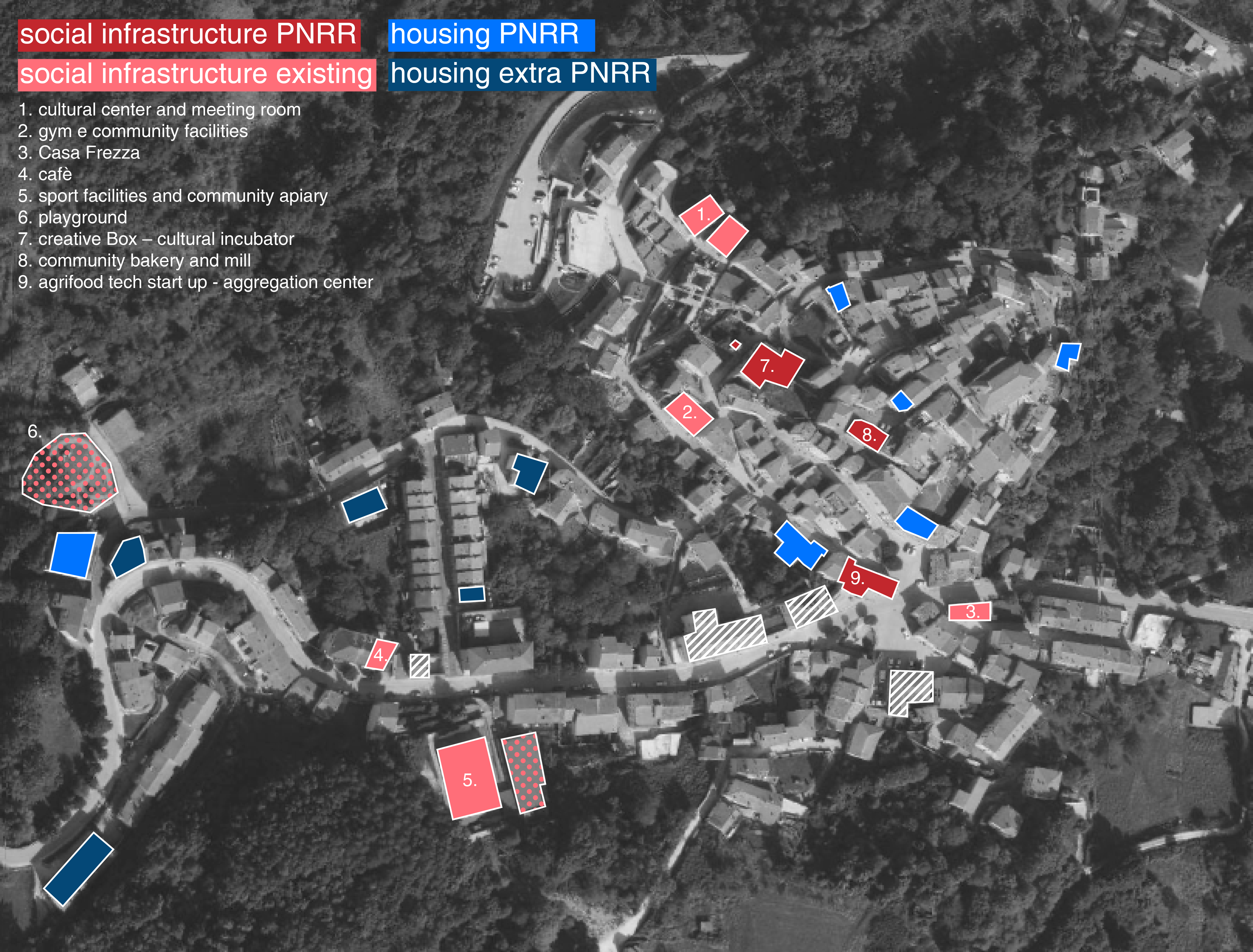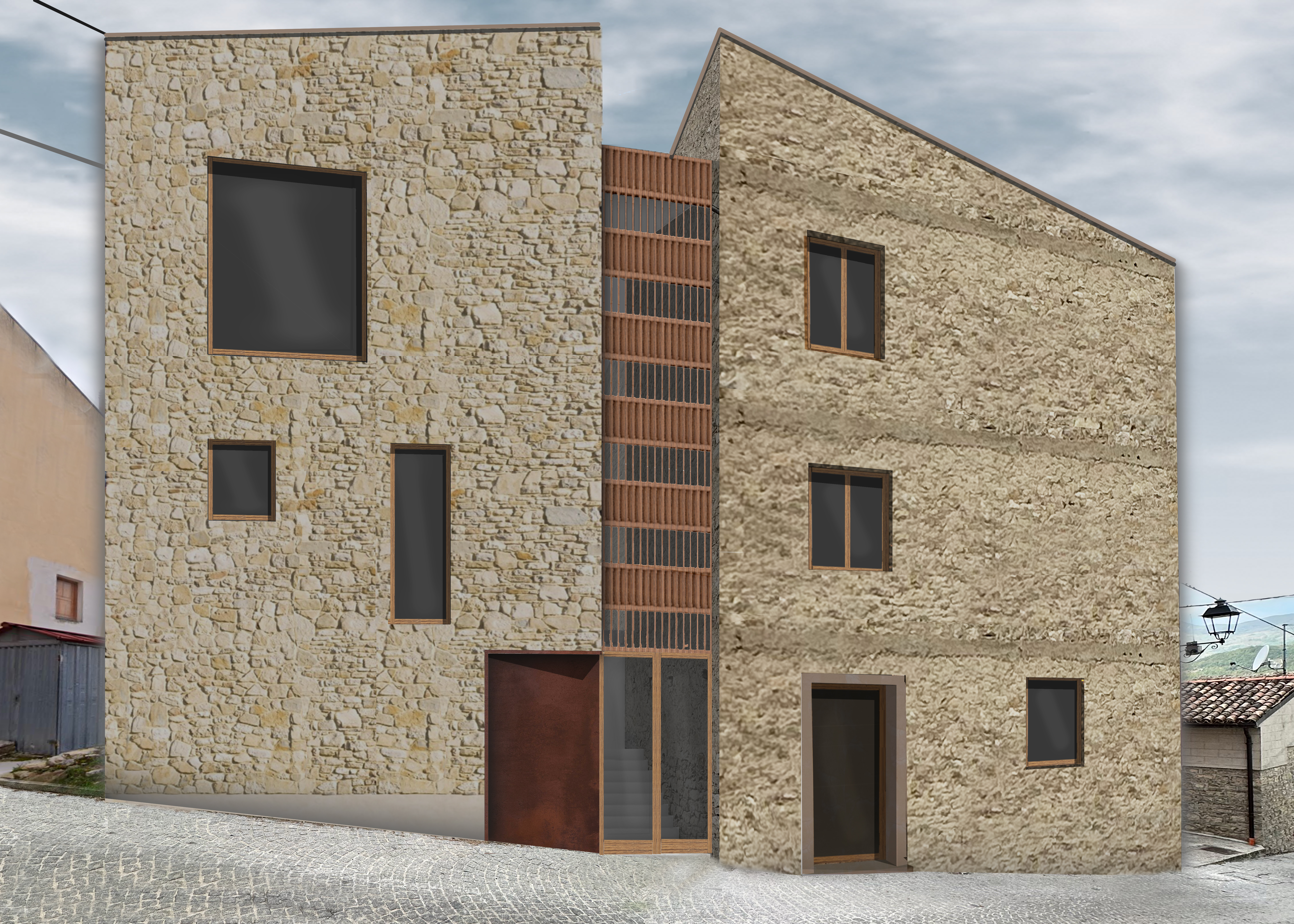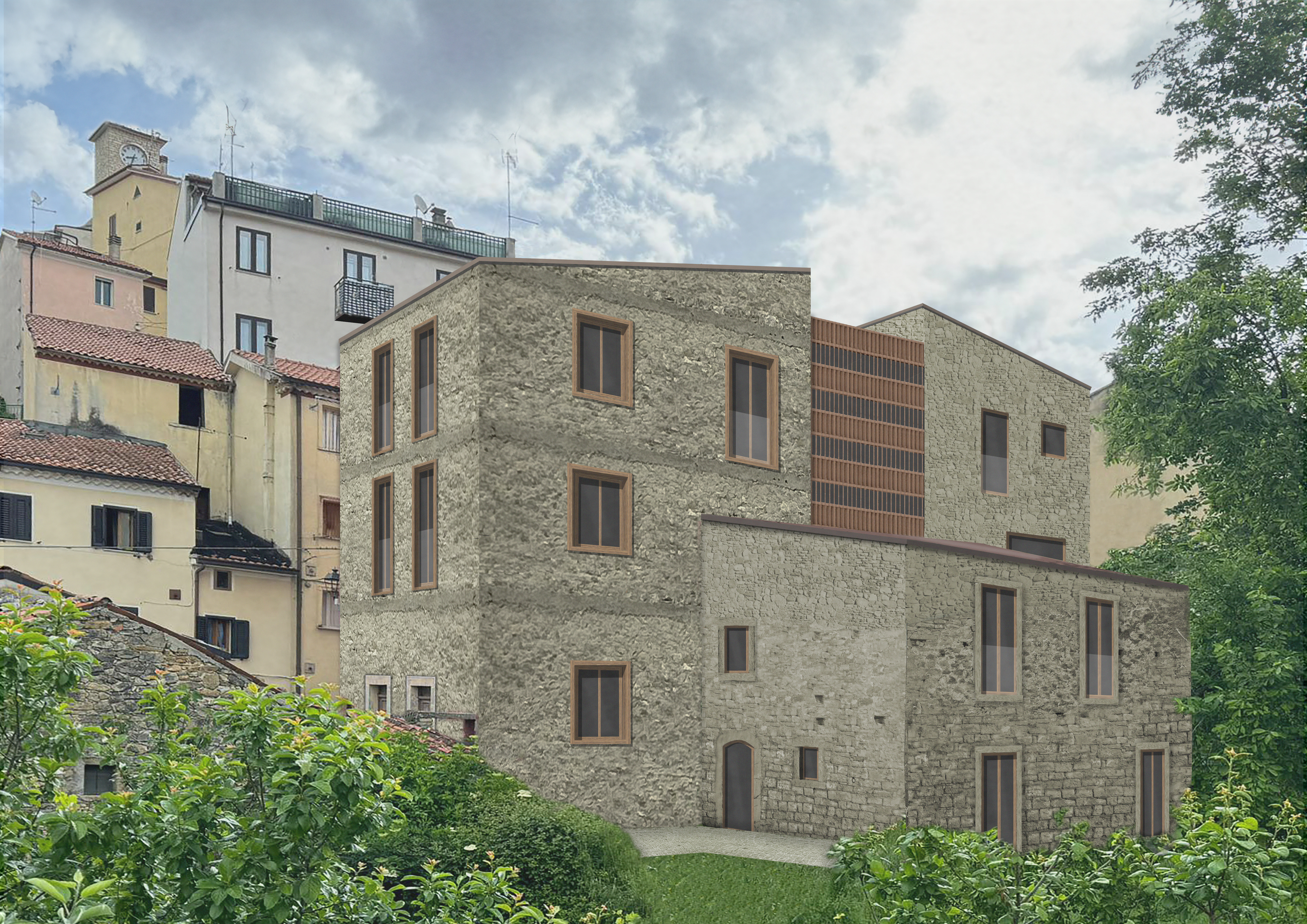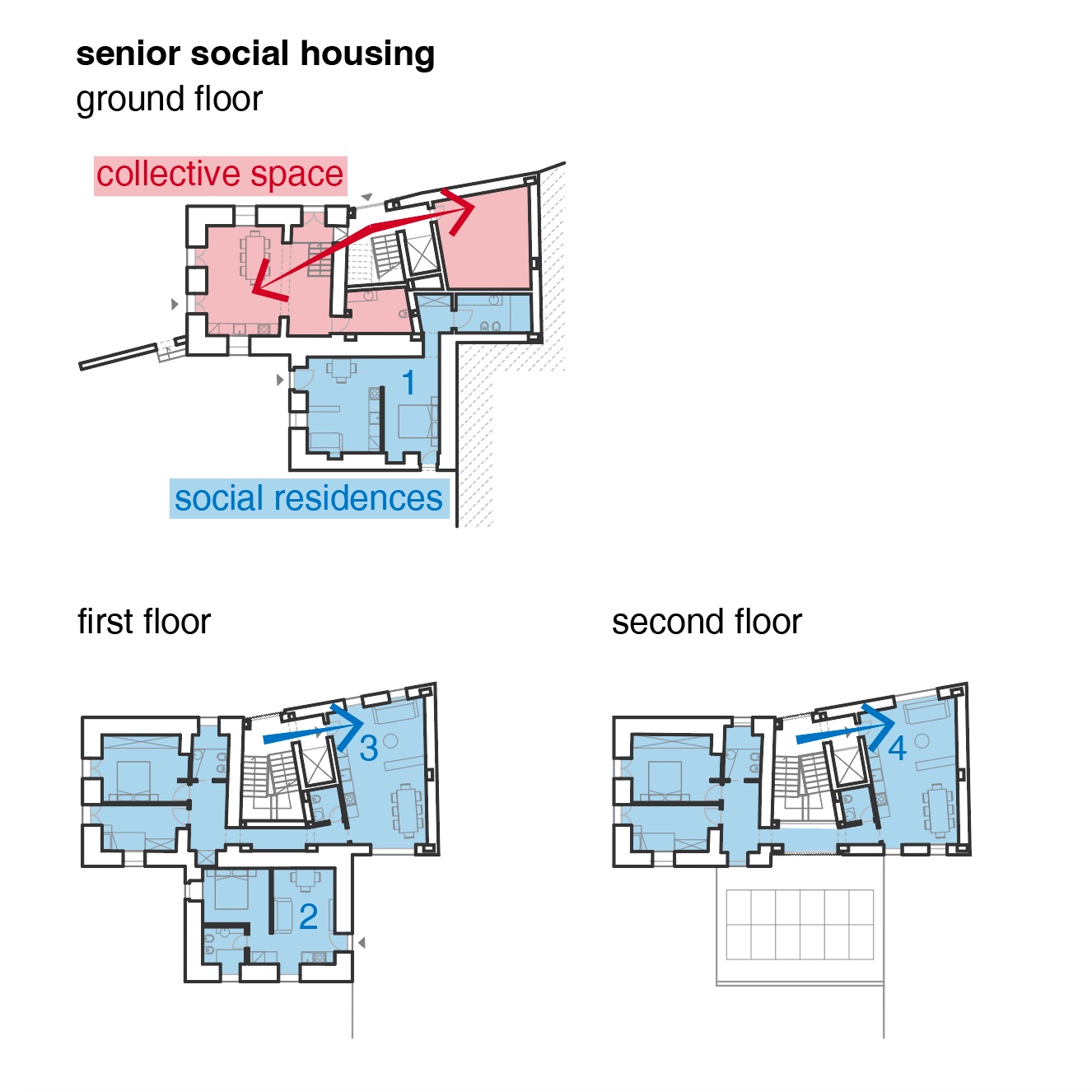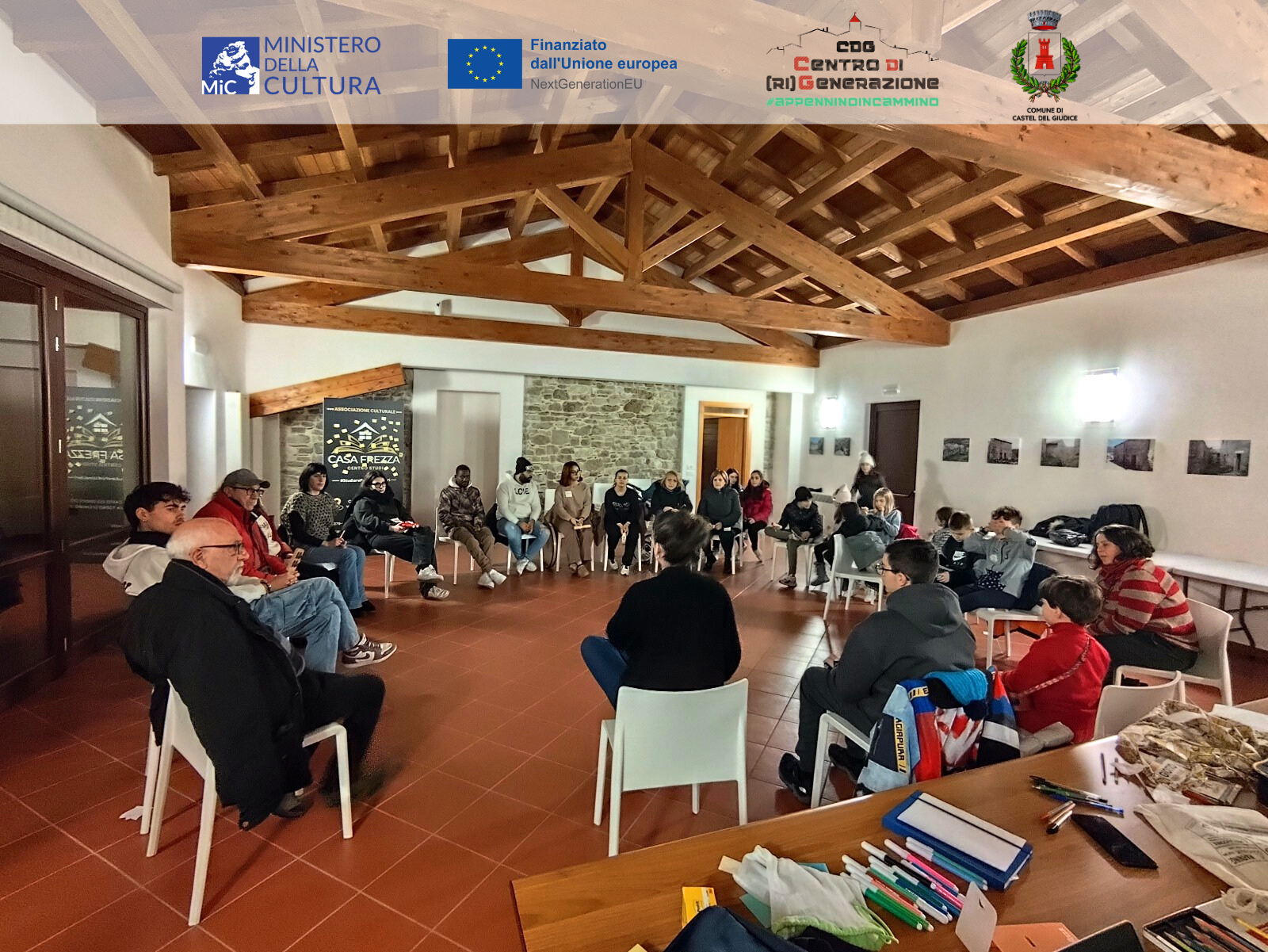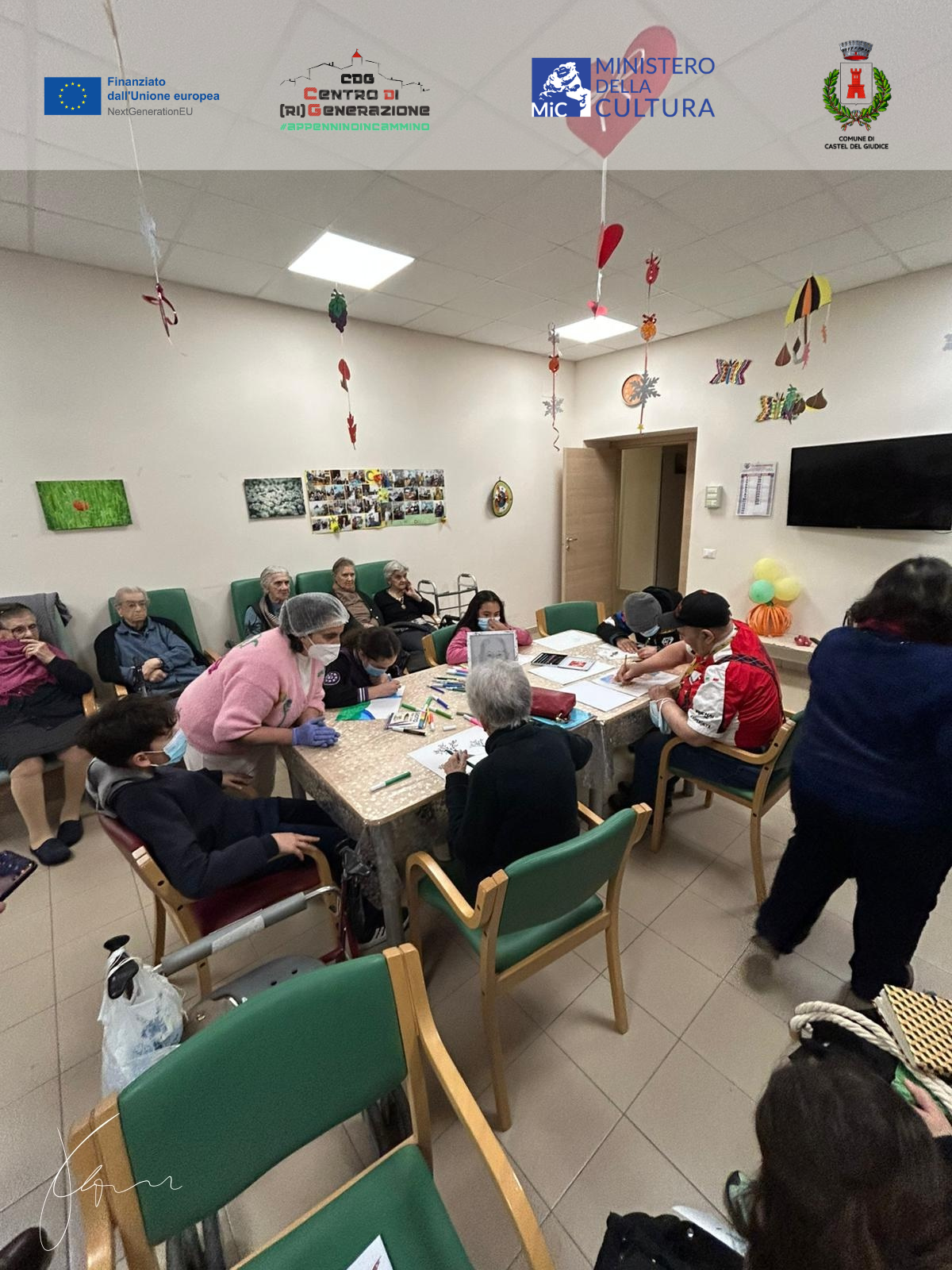Centro di (ri)Generazione
Centro di (ri)Generazione - Residential and Cultural Attractiveness for the Apennines
We are transforming Castel del Giudice through a comprehensive regeneration strategy integrating cultural revitalisation, innovative social housing, and community-driven development. By fostering co-designed shared spaces, sustainable resource reuse, and inclusive communication, we create lasting opportunities for residents and newcomers. Join us in shaping a resilient and sustainable rural future.
Italy
Castel Del Giudice, 86080, Isernia (IT)
Prototype level
Yes
Yes
Yes
Yes
NEXT GENERATIONEU
No
094009: Castel del Giudice (IT)
The “Centro di (ri)Generazione - Residential and Cultural Attractiveness for the Apennines” initiative aims to revitalize Castel del Giudice by strengthening its social and economic fabric to promote territorial regeneration and repopulation. Supported by the Italian Ministry of Culture, the municipality is a pilot project for a new population growth strategy. The first phase focused on essential infrastructure and services, including an Assisted Living Facility to support the aging population, a cooperative initiative to revive uncultivated land by reintroducing ancient apple varieties, a craft brewery to enhance local production, and a publicly funded gym promoting well-being. Building on these foundations, recent investments - particularly through the PNRR - have expanded opportunities for economic and cultural revitalization, with the creation of a Creative Hub and a business incubator designed to attract new entrepreneurial initiatives and foster long-term sustainability. However, the need to work on residential issues came alongside these economic and cultural drivers, which has become a pillar of the regenerative strategy. There are two actions the municipality is working on: (1) the activation of Senior Social Housing to meet the needs of the aging population and (2) the promotion of diffuse social housing to ensure affordable housing for new residents to settle in the area. In both cases, these interventions introduce contemporary living solutions, incorporating communal spaces, smart-working residences, and accommodations for return tourism. The initiative addresses two main groups: on one hand, vulnerable residents in need of stable and affordable housing; on the other, individuals and families looking to relocate, bringing fresh energy and contributing to the town’s social and economic growth.
Repopulation
Social Housing
Cultural and Community-Led Territorial Regeneration
Design
Sustainability
The initiative is firmly rooted in sustainability principles with a strategic approach focused on efficiently using existing resources, reducing environmental impact, and promoting energy efficiency. One of the core aspects of the initiative is the reuse of existing buildings; instead of demolishing and rebuilding, the project prioritises rehabilitation and repurposing, thereby preserving architectural heritage while minimising construction waste and resource consumption. This strategy reduces the carbon footprint of new developments and promotes a responsible, innovative and community-based housing model. The project also reduces environmental impact through the Renewable Energy Community (REC) to further enhance sustainability. This initiative fosters the local production and the sharing of renewable energy, optimising consumption and reducing reliance on fossil fuels; integrating smart grids and energy storage solutions ensures an efficient and resilient energy distribution model. Equipping the building with renewable energy sources, particularly solar photovoltaic panels, also makes the intervention part of a broader energy strategy in the village. In conclusion, the project prioritises low-energy-demand buildings by employing advanced insulation, airtight designs, and natural ventilation strategies to reduce energy waste. These measures enhance indoor comfort while lowering heating and cooling demands, making buildings more sustainable in the long term. There are integrated high-efficiency thermal systems for thermal energy management, such as heat pumps, district heating networks, and innovative HVAC solutions. These systems optimise energy consumption, ensuring reduced emissions and improved efficiency. The approach aligns with global sustainability goals and national laws and creates a cleaner environment.
The project revitalizes existing buildings through rehabilitation, enhancing spatial quality and the living experience. Residential and communal areas ensure broad usability, integrating advanced technologies to reduce noise, optimize air exchange, and maximize natural light—key factors for well-being. Thoughtful material selection and lighting create aesthetically and emotionally enriching spaces. Nestled in the heart of the Apennines, Castel Del Giudice offers a unique rural and mountainous landscape, where rolling hills and forests provide a restorative environment. This deep connection with nature fosters a balanced, fulfilling lifestyle, reinforcing the town’s identity and cultural continuity. Sustainability is central to the initiative, with local materials and traditional techniques ensuring harmony between old and new while supporting environmental and economic resilience. Shared spaces are designed to strengthen community ties, fostering social interactions and inclusion. Multifunctional areas and public spaces encourage engagement, creating a vibrant environment where residents and newcomers can connect to set up social bonds. The project reimagines living in rural contexts, promoting sustainability and conviviality while offering a high-quality, nature-integrated lifestyle.
The principle of “together” is central to the project, based on twofold exchange: 1. Ecosystemic: New inhabitants are integrated into community services like the community oven, artistic residency, gym, and smart-working residencies. The "together" concept evolves as the town develops, supported by community mapping and monitoring. Regenerative initiatives, including urban and economic rehabilitation, foster this evolution. A cultural incubator will host a theater school led by elderly residents, and the community oven will facilitate knowledge exchange between young apprentices and professionals, promoting social and economic integration. 2. Human: Intergenerational knowledge exchange fosters a vibrant dialogue. Elderly residents share wisdom with younger generations, while the Casa Frezza Study Center will design nature activities to enhance environmental appreciation. Training and cultural events, led by elderly professors, will address educational poverty and immigrant youth inclusion. Women in Senior Social Housing, local women, and immigrants will exchange skills, building a new social model based on co-design and collaboration. Moreover, the community psychology project has worked towards the engagement of locals in recognizing their role as community resources, using educational methods to empower individuals and encourage innovation. Castel del Giudice also adopted the Community Pact, where local actors contribute to a shared governance model. Supported by the PNRR (National Recovery and Resilience Plan), this model evaluates sustainability and activates policies to improve well-being. 3. Sustainability: The participatory approach, co-designed with authorities and citizens, aims for energy independence. A renewable energy community (REC) will generate electricity via photovoltaic panels. The community cooperative governs the REC, managing functions and reinvesting profits to expand energy infrastructure.
The housing system and community services planned for Castel del Giudice’s new urban and human geography will impact both the current residents and the future inhabitants of the Senior Social Housing (SSH). The introduction of new services, designed to evolve in continuous interaction with the community, will strengthen the connection between citizens and the town’s livability, fostering a shared vision for growth and improvement. A key tool for understanding community needs has been the Community Map, developed through a scientific study by the Centro BIOCULT of the Department of Humanities, Social Science and Education at the University of Molise. Over 100 participants contributed to this effort, with the respondent pool comprising 1) locals and workers, and 2) tourists. The questionnaire was structured into four sections: 1) Commitment, 2) Social Bonds, 3) Traditions and Togetherness, and 4) Evolution and Transformation. The responses revealed strong enthusiasm for the town’s current and future evolution. Participants expressed a deep interest in how the town can grow while maintaining its community spirit, and they offered valuable ideas for strengthening the connection between the project and the people it serves. This feedback has been instrumental in shaping the ongoing redevelopment efforts, ensuring that the transformation of the town aligns with the needs and aspirations of both the existing and new residents. By actively involving the community in the planning process, the initiative fosters a sense of ownership and collaboration, ensuring that the project is not only beneficial but also sustainable and responsive to the needs of those it aims to serve. Attached in the “07_Communitymap” is the graphic representation of the results achieved through the community map.
The initiative follows a participatory approach, engaging a range of stakeholders at multiple levels, all guided by the vision fostered by the Municipality of Castel del Giudice and its community. 1. Local Level: The project benefits from the involvement of companies in public and private partnerships by the Municipality, such as the organic agricultural business "Melise," the Assisted Living Facility San Nicola, the Community Beekeeping initiative, the Diffused Hotel and SPA of Borgo Tufi. These services have fostered a vision of wellness and tranquility, embracing the "slow life" ethos of small rural towns. Additional stakeholders, like the town’s supermarket and the only remaining bar, also stand to benefit. The non-profit organization Casa Frezza plays a key cultural role, organizing after-school programs, literary festivals, and promoting integration between the local and immigrant communities. 2. National Level: At the national level, academic institutions such as Università del Molise, the University of L'Aquila, and the Politecnico of Torino are contributing to the design of the town’s immaterial heritage and urban architecture. The project is supported by the Italian Ministry of Culture as a pilot for urban regeneration aimed at repopulating rural areas. It aligns with the SNAI (Strategia Nazionale Aree Interne), which supports long-term revitalization efforts for Castel del Giudice and neighboring towns, ensuring the distribution of essential services over the next seven years. 3. European Level: On the European scale, the project supports sustainable development, social inclusion, and intergenerational solidarity, particularly through the NEXt GENERATIONEU funding system for a more resilient Europe.
Castel del Giudice is experimenting with new forms of social organization for urban and land management, introducing innovative approaches and social codes. The initiative can be framed as a quadruple helix model, which brings together four key actors: the university, as a generator of knowledge and innovation; industry, particularly public-private businesses; the administration/municipality, which creates the institutional framework to support innovation and facilitates regulatory policies; and civil society/citizens, who co-design political choices, research, and innovation to address social and territorial needs. The municipality has adopted expropriation for public utility to create the housing system, which has allowed the revitalization of abandoned buildings that once belonged to families who emigrated. The project’s success is also attributed to its academic transdisciplinary approach, which integrates a variety of disciplines, including architecture, urban planning, anthropology, social sciences, and philosophy. This comprehensive perspective ensures the initiative incorporates multiple viewpoints and fosters collaboration among experts, turning Castel del Giudice into an open urban laboratory for new inhabitants. On the urban regeneration front, urban planners and architects are supported by researchers from the Politecnico di Torino’s Interuniversity Department of Regional and Urban Studies and Planning (DIST) and the Department of Architecture and Design (DAD), especially in the design of the housing system. Meanwhile, the University of Molise, through its Department of Humanities, Social Sciences, and Education, has contributed with studies on community psychology, closely monitoring the evolution of Castel del Giudice’s societal structure about the project’s implementation and the ongoing transformations in the urban landscape.
This initiative proposes an integrated approach to culture-led regeneration, moving beyond traditional heritage conservation and fragmented interventions. Unlike conventional strategies, the project creates a holistic vision in which cultural, social and economic development are intertwined to foster sustainable repopulation. One of the most innovative elements is the centrality of social infrastructure as a driver of regeneration. Rather than simply providing economic incentives or housing, the project builds an integrated ecosystem of housing, services and cultural spaces capable of attracting new residents and strengthening the local community. Another key innovation is the adaptive reuse of underused or disused buildings. The initiative rehabilitates disused spaces and transforms them into affordable and energy-efficient housing alongside multifunctional community spaces. Finally, the project adopts participatory processes, guaranteeing the community an active role in co-designing spaces and services. Through the shared creation of public spaces, collective facilities and a 'Community Toolbox', the initiative enhances local expertise and promotes lasting participation, transforming the built environment into an authentic expression of the community's needs and aspirations rather than a result of top-down planning.
This initiative's key and innovative methodology is using expropriation as a tool for community-led land regeneration. Unlike conventional regenerative processes, this approach allows for the reappropriation of underused or abandoned public and private buildings, preventing their degradation and reusing them for collective benefit. In Castel del Giudice, expropriation is a legal mechanism and a strategic lever for repopulation and socio-economic revitalization. By reclaiming vacant, abandoned or decaying properties, the initiative ensures their conversion into affordable housing, community spaces and productive and social infrastructures, directly addressing the needs of both residents and newcomers. This is a strategy that has also been consolidated in previous regenerative projects. The Melise agricultural cooperative is a key example, where abandoned farmland was reclaimed to create a sustainable, community-driven agricultural system. By reintroducing ancient apple varieties, the initiative has revived local biodiversity and generated job opportunities and new economic activities, strengthening the link between territorial regeneration and local livelihoods. Similarly, Borgo Tufi transformed a group of abandoned rural dwellings into a widespread hospitality system, demonstrating how the reuse of built heritage can become an engine of cultural and economic renewal. In both cases, the starting point was the valorization of abandoned heritage. This methodology departs from traditional territorial policies, often leaving abandoned assets in legal limbo or at risk of speculative development. Instead, it establishes a framework of public-private collaboration, in which the municipality leads a transformation process that ensures that regenerated spaces serve the community rather than private profit interests.
The Castel del Giudice Centro di (Ri)generazione project has been recognized by the Italian Ministry of Culture for its innovative approach and potential for replication in other towns facing population decline. This project offers a set of methodologies, processes, and results that can be applied to other depopulated areas, making it a promising model for revitalization. Two core aspects stand out for their transferability: 1. Expropriation for public use in depopulated areas. This process allows the revitalization of abandoned properties, transforming them into housing and community services such as cultural centers, social spaces, and services for the local population. By reclaiming unused buildings, this approach ensures that valuable real estate is put to social and economic use. 2. Public-Private Partnerships this model encourages collaboration with a focus on shared goals, not just organizational profit. It strengthens community ties and creates sustainable, long-term value by aligning business interests with social objectives, making it a robust tool for community regeneration. The Municipality of Castel del Giudice is further expanding this model by creating the Fondazione di Partecipazione (Participation Foundation), a spin-off designed to support other depopulated towns. This foundation will provide urban regeneration expertise and share the lessons learned from years of successful implementation. Its role will be to guide other communities through the process of urban renewal, emphasizing the need for a multidisciplinary team to address complex social, economic, and environmental issues. The foundation will also employ the co-design method, ensuring that all stakeholders, from local authorities to residents, actively participate in shaping the regeneration plans.
The project was created to tackle the pressing issue of population shrinkage that is affecting rural and mountainous areas, as well as small islands. Depopulation in these regions is driven by the centripetal force of large urban centers, which attract people seeking better economic opportunities and services. As a result, these areas face economic decline, loss of culture, and a diminishing sense of community. By addressing depopulation, the project also provides solutions to broader global challenges like overtourism and sustainability. Overtourism is a growing issue in major tourist destinations, where excessive visitors strain infrastructure and resources. The project CDG - Centro di (ri)Generazione helps alleviate this problem by revitalizing small towns and encouraging sustainable, nature and wellness-based tourism, offering a balance to overcrowded cities. Additionally, the project promotes environmental sustainability by utilizing local resources to create a green community, reducing the carbon footprint and environmental impact that often accompanies urbanization. The initiative focuses on providing essential services in the town, fostering a sense of belonging, and creating a strong community in a time marked by individualism and isolation. By restoring abandoned buildings for housing and common services, it revitalizes forgotten spaces and brings new life to the area. The project’s goal is to develop a co-designed town, where both permanent residents and newcomers collaborate to shape a sustainable, thriving environment.
The initiative aims to strengthen community togetherness and foster participatory processes in the short term while enhancing innovative methods for improving livability in the long term. In the near future, the project will focus on the Rooting Phase, which involves co-designing strategies and communication tools to encourage active participation from social housing residents—both new and long-standing—in shaping their environment. A key element of this phase is the co-design of common space furniture for social housing projects, incorporating repurposed construction waste to ensure accessibility for all, including elderly residents and people with disabilities. At the same time, the initiative will develop co-designed communication tools to promote environmental and Renewable Energy Community awareness. It will enable residents to create infographics that encourage responsible water usage, energy consumption, and waste management. Additionally, a stylized graphic novel aimed at younger generations will help engage them in the narrative of Castel del Giudice’s repopulation and regeneration journey, strengthening their connection to the community.A Community Toolbox will facilitate the exchange of skills and knowledge, reinforcing the residential and cultural ecosystem which will serve to the community services planned in the CDG - Centro di (ri)Generazione. For the long-term development, Castel del Giudice plans to expand community services during the Research and Development Phase. Currently, 5% of its infrastructure is dedicated to social housing or shared spaces (File 01_Map). The goal is to increase the system of common services and housing across the town, aligning services with population growth through public-use expropriation. Innovation will also be enhanced by studying new housing models and establishing the Fondazione di Partecipazione, which will support sustainable development and the dissemination of expertise.

